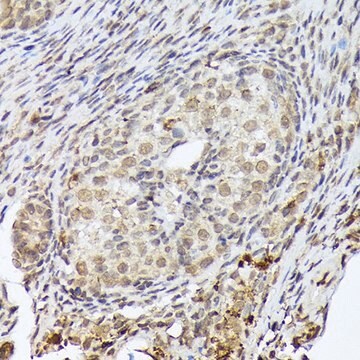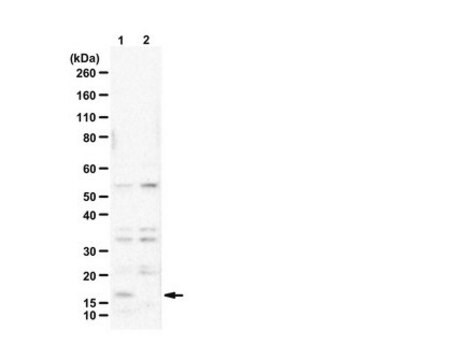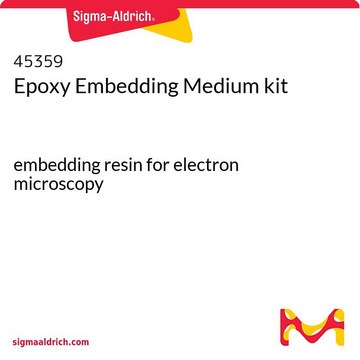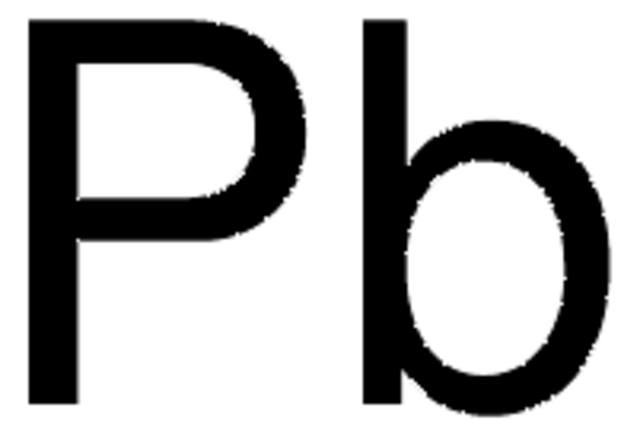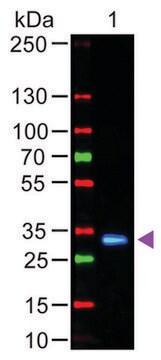ABE1889
Anti-ZMYND11 Antibody
serum, from rabbit
Synonym(e):
Zinc finger MYND domain-containing protein 11
About This Item
Empfohlene Produkte
Biologische Quelle
rabbit
Qualitätsniveau
Antikörperform
serum
Antikörper-Produkttyp
primary antibodies
Klon
polyclonal
Speziesreaktivität
human
Speziesreaktivität (Voraussage durch Homologie)
mouse (based on 100% sequence homology)
Methode(n)
ChIP: suitable (ChIP-seq)
western blot: suitable
NCBI-Hinterlegungsnummer
UniProt-Hinterlegungsnummer
Versandbedingung
dry ice
Posttranslationale Modifikation Target
unmodified
Angaben zum Gen
mouse ... Zmynd11(66505)
Allgemeine Beschreibung
Spezifität
Immunogen
Anwendung
Epigenetik & nukleäre Funktionen
Chromatin-Biologie (ChIP)
Chromatin Immunoprecipitation Analysis: A representative lot detected ZMYND11 occupancy of c-Myc gene by ChIP using human osteosarcoma U2OS cell nuclear extracts. ZMYND11 shRNA treatment greatly reduced the c-Myc gene fragments in ChIP (Courtesy of Dr. Hong Wen, UT M.D. Anderson Cancer Center, TX).
Chromatin Immunoprecipitation (ChIP) Analysis: A representative lot detected ZMYND11 chromatin occupancy by ChIP using chromatin preparations from human osteosarcoma U2OS cells. Decreasing H3K36me3 level by SETD2 knockdown reduced ZMYND11 target genes association (Wen, H., et al. (2014). Nature. 508(7495):263-268).
ChIP-seq Analysis: A representative lot detected ZMYND11-targeted chromatin sites by a genome-wide ChIP-seq analysis using chromatin preparations from human osteosarcoma U2OS cells. The ZMYND11 occupied sites are highly enriched in introns and exons, but not promoters of targeted genes (Wen, H., et al. (2014). Nature. 508(7495):263-268).
Western Blotting Analysis: A representative lot detected exogenously expressed human BS69 protein in yeast and QT-6 quail fibroblasts (Ladendorff, N.E., et al. (2001). Oncogene. 20(1):125-132).
Qualität
Western Blotting Analysis: A 1:500 dilution of this antibody detected ZMYND11 in 20 µg of U2OS nuclear extract.
Zielbeschreibung
Physikalische Form
Lagerung und Haltbarkeit
Handling Recommendations: Upon receipt and prior to removing the cap, centrifuge the vial and gently mix the solution. Aliquot into microcentrifuge tubes and store at -20°C. Avoid repeated freeze/thaw cycles, which may damage IgG and affect product performance.
Sonstige Hinweise
Haftungsausschluss
Sie haben nicht das passende Produkt gefunden?
Probieren Sie unser Produkt-Auswahlhilfe. aus.
Lagerklassenschlüssel
12 - Non Combustible Liquids
WGK
WGK 1
Flammpunkt (°F)
Not applicable
Flammpunkt (°C)
Not applicable
Analysenzertifikate (COA)
Suchen Sie nach Analysenzertifikate (COA), indem Sie die Lot-/Chargennummer des Produkts eingeben. Lot- und Chargennummern sind auf dem Produktetikett hinter den Wörtern ‘Lot’ oder ‘Batch’ (Lot oder Charge) zu finden.
Besitzen Sie dieses Produkt bereits?
In der Dokumentenbibliothek finden Sie die Dokumentation zu den Produkten, die Sie kürzlich erworben haben.
Unser Team von Wissenschaftlern verfügt über Erfahrung in allen Forschungsbereichen einschließlich Life Science, Materialwissenschaften, chemischer Synthese, Chromatographie, Analytik und vielen mehr..
Setzen Sie sich mit dem technischen Dienst in Verbindung.
